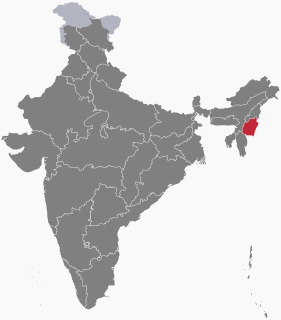
Manipur is a state in Northeast India, with the city of Imphal as its capital. It is bounded by the Indian states of Nagaland to the north, Mizoram to the south and Assam to the west. It also borders two regions of Myanmar, Sagaing Region to the east and Chin State to the south. The state covers an area of 22,327 square kilometres (8,621 sq mi). Meitei language is the most widely spoken language and is also the official language of the state, spoken natively by the Meiteis and as a lingua franca by the Nagas, Kukis, Zomis and other smaller communities, who speak a variety of Sino-Tibetan languages. Manipur has been at the crossroads of Asian economic and cultural exchange for more than 2,500 years. It connects the Indian subcontinent and Central Asia to Southeast Asia, East Asia, Siberia, regions in the Arctic, Micronesia and Polynesia enabling migration of people, cultures and religions.

Meitei, also known as Manipuri, is a Tibeto-Burman language of north-eastern India. It is spoken by around 1.8 million people, predominantly in the state of Manipur, but also by smaller communities in the rest of the country and in parts of neighbouring Myanmar and Bangladesh. It is native to the Meitei people, and within Manipur it serves as an official language and a lingua franca. It was used as a court language in the historic Manipur Kingdom and is presently included among the 22 scheduled languages of India.

The Meitei people, also known as the Manipuri people, is an ethnic group native to the state of Manipur in northeastern India. The Meiteis primarily settled in the Imphal Valley region in modern-day Manipur, though a sizable population has settled in the other Indian states of Assam, Tripura, Nagaland, Meghalaya, and Mizoram. There is also a notable presence of Meitei in the neighboring countries of Myanmar and Bangladesh. The Meitei ethnic group represents about 53% of Manipur's population.
In the Bombay riots in December 1992 and January 1993, an estimated 900 people died. The riots were mainly due to escalations of hostilities after large scale protests by Muslims in reaction to the 1992 Babri Masjid Demolition by Hindu Karsevaks in Ayodhya; and by Hindu mobs in regards with the Ram Temple issue.

The Meitei Pangals, also known as the Pangals or the Meitei Muslims or the Manipuri Muslims, are a group of Muslims who speak Meitei language as their native tongue. They live mainly in Manipur. The term "Pangal" simply means "Muslim" in Meitei language. Various historical sources have different dates for when Islam first entered Manipur. However, the date all sources seem to confirm as definitive is 1606 AD. The origin of the Pangal community is equally varied.

The Meitei script (ꯃꯩꯇꯩ ꯃꯌꯦꯛ) or the Meetei script is an abugida used for the Meitei language, the official language of Manipur state of India. Its earliest known evidence of existence dates back to the 6th century AD coins, engraving the Meitei letters, as verified by the various publications of the National Sahitya Akademi. It was used until the 18th century, when it was replaced by the Bengali alphabet. A few manuscripts survive. In the 20th century, the script has experienced a resurgence, and is again being used. Starting from the year 2021, Meitei script was officially used by the Government of Manipur, along with the Bengali script, to write the Meitei language, as per "The Manipur Official Language (Amendment) Act, 2021".

The 2002 Gujarat riots, also known as the 2002 Gujarat violence, was a three-day period of inter-communal violence in the western Indian state of Gujarat. The burning of a train in Godhra on 27 February 2002, which caused the deaths of 58 Hindu pilgrims and karsevaks returning from Ayodhya, is cited as having instigated the violence. Following the initial riot incidents, there were further outbreaks of violence in Ahmedabad for three months; statewide, there were further outbreaks of violence against the minority Muslim population of Gujarat for the next year.

Chinglen Nongdrenkhomba (1788–1834), also known as Raja Gambhir Singh, was a ruler of the Manipur Kingdom.
Religious violence in India includes acts of violence by followers of one religious group against followers and institutions of another religious group, often in the form of rioting. Religious violence in India has generally involved Hindus and Muslims.

The Naroda Patiya massacre took place on 28 February 2002 at Naroda, in Ahmedabad, India, during the 2002 Gujarat riots. 97 Muslims were killed by a mob of approximately 5,000 people, organised by the Bajrang Dal, a wing of the Vishva Hindu Parishad, and allegedly supported by the Bharatiya Janata Party which was in power in the Gujarat State Government. The massacre at Naroda occurred during the bandh (strike) called by Vishwa Hindu Parishad a day after the Godhra train burning. The riot lasted over 10 hours, during which the mob looted, stabbed, sexually assaulted, gang-raped and burnt people individually and in groups. After the conflict, a curfew was imposed in the state and army troops were called in to contain further violence.

The 1980 Moradabad riots, also known as the Moradabad Muslim Massacre, refers to violence that happened in the Indian city of Moradabad during August–November 1980. When a pig entered the local Idgah during the Eid festival prayer on 13 August, local Muslims asked the police to remove the pig, but the police refused to do so. This led to a confrontation between the police and the Muslims. The police responded with indiscriminate firing, which led to over one hundred deaths. This was followed by a series of violent incidents which became religious in nature, and led to arson, looting and murders.

The clashes between the Hindu and Muslim communities in Muzaffarnagar district of Uttar Pradesh, India in August–September 2013, resulted in at least 62 deaths including 42 Muslims and 20 Hindus and injured 93 and left more than 50,000 people displaced. By date 17 September, the curfew was lifted from all riot affected areas and the army was also withdrawn.
There have been several instances of religious violence against Muslims since the partition of India in 1947, frequently in the form of violent attacks on Muslims by Hindu nationalist mobs that form a pattern of sporadic sectarian violence between the Hindu and Muslim communities. Over 10,000 people have been killed in Hindu-Muslim communal violence since 1950 in 6,933 instances of communal violence between 1954 and 1982.
The 1987 Meerut massacre were a series of violent communal disturbances between Hindus and Muslims in the northern Uttar Pradesh town Meerut which occurred from March to June 1987, which resulted in the death of more than 100 people.
Ningthoukhongjam Khelchandra Singh was an Indian writer, lexicographer and historian, known as the author of Manipuri to Manipuri and English, the first modern general dictionary in Meitei language, which was published in 1964. He was a fellow of the Sahitya Akademi and Sangeet Natak Akademi. The Government of India awarded him the fourth highest civilian honour of Padma Shri in 1987.

Meitei architecture or Manipuri architecture is the architecture produced by the Meitei speaking people, whose culture flourished in the Kangleipak kingdom and its neighbouring kingdoms from the middle of the fifteenth century BC. The Meitei architecture is best known for its temples, found scattered in the Kangleipak. Other architectural forms that are still in existence are the grand gates (Hojang), Traditional houses (Yumjao), Public houses (Sanglen), Official buildings (Loishang), etc.

The 2020 Delhi riots, or North East Delhi riots, were multiple waves of bloodshed, property destruction, and rioting in North East Delhi, beginning on 23 February 2020 and caused chiefly by Hindu mobs attacking Muslims. Of the 53 people killed, two-thirds were Muslims who were shot, slashed with repeated blows, or set on fire. The dead also included a policeman, an intelligence officer and over a dozen Hindus, who were shot or assaulted. More than a week after the violence had ended, hundreds of wounded were languishing in inadequately staffed medical facilities and corpses were being found in open drains. By mid-March many Muslims had remained missing.
Muhammad Sani was a 17th-century nobleman who led the first settlement of Manipuri Muslims into the Manipur Kingdom, what is now the Indian state of Manipur. After invading the region in alliance with a renegade prince, Sani and his troops were captured by King Khagemba, who integrated them into Manipuri society. Sani eventually became a prominent figure in the royal court and aided in the establishment of subsequent Muslim migrants. He and his family are the ancestors of a number of present-day Pangal clans.

Meitei Language Day, also known as Manipuri Language Day, is observed annually on 20 August. It is a commemoration of the day on which Meitei language was included in the Eighth Schedule to the Constitution of India and made one of the languages with official status in India on the 20th August, 1992.










